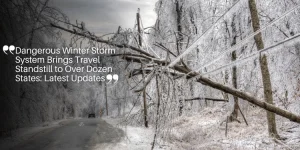Weathering the Storm: Nova Scotia’s Unprecedented Snowfall Event
By: Emilly Correa Posted in: August 19, 2024 Last Update: August 13, 2025

The recent blanket of snow that enveloped Nova Scotia painted a picturesque winter scene, but for its residents, it marked a historic event of exceptional magnitude.
While snow is not uncommon in this region, the intensity and challenges posed by this snowfall were unprecedented, leaving a lasting impact on communities across the province.
Regions and Communities Affected
From the coastal allure of Halifax to the rural landscapes of Cape Breton, the entire province felt the weight of the snowstorm’s icy embrace.
Snowdrifts reached heights unseen in decades, transforming streets into tunnels and landmarks into snow-covered relics.
Despite the visual beauty, the disruption to daily life was palpable, affecting residents from all walks of life.
Immediate Consequences of the Snowfall
The aftermath of the snowstorm brought immediate challenges, reverberating throughout the province. School closures left parents scrambling for childcare solutions, while local states of emergency underscored the severity of the situation. Transport networks faced chaos, with delays and cancellations impacting commuters and businesses alike. Infrastructure strained under the weight of snow, risking outages and damage.
- School Closures: Disrupting routines and prompting unexpected challenges for families.
- Local State of Emergency: Signifying the gravity of the situation and enabling extraordinary measures.
- Transportation Disruptions: Hampering travel and connectivity, affecting both individuals and commerce.
- Infrastructure Challenges: Straining buildings and power lines, posing risks of outages and damage.
The Human Impact
As emergency service calls surged and car accidents increased, the human toll of the snowstorm became evident. Stranded motorists faced hours of uncertainty, while the threat of building collapses loomed large. The resilience of first responders and the acts of kindness among neighbors provided glimpses of hope amidst the challenges.
- Service Calls: Stretching the capacity of first responders, highlighting the need for swift action.
- Car Accidents: Heightening risks on treacherous roads, emphasizing the importance of caution.
- Stranded Motorists: Facing cold and uncertainty, underscoring the urgency of assistance.
- Building Collapses: Posing silent threats to safety, necessitating vigilance and precaution.
Coping with the Aftermath: Community Responses and Challenges
As Nova Scotians rallied to address the aftermath of the snowstorm, community spirit and local initiatives emerged as beacons of hope.
Residents banded together to assist those in need, while emergency services and road crews worked tirelessly to restore normalcy.
However, challenges persist as the province navigates the road to recovery.
Community Response to the Snowstorm
In the face of adversity, communities demonstrated resilience and solidarity. Neighbors checked on one another, volunteers offered assistance, and social media served as a platform for coordination.
Acts of kindness, from providing shelter to clearing snow-covered paths, exemplified the spirit of compassion and support.
Challenges for Emergency Services and Road Crews
Emergency services and road crews faced formidable challenges in the aftermath of the snowstorm.
Despite their efforts, impassable roads and strained resources hindered response times and recovery efforts. Plows worked tirelessly, but the scale of the task remained daunting, impacting both safety and mobility.
Resilience and Solidarity
Amidst the challenges, stories of resilience and solidarity emerged, illustrating the strength of community bonds. Strangers formed human chains to rescue trapped individuals, while local businesses opened their doors to provide warmth and sustenance.
These acts of kindness underscored the power of collective action in times of crisis.
Lessons from Past Winter Events and Preparedness for the Future
Reflecting on past winter events, Nova Scotia has gleaned valuable lessons on resilience and preparedness.
Each storm serves as a reminder of the importance of adaptation and mitigation efforts in mitigating the impacts of extreme weather.
Historical Winter Events in Nova Scotia
Historical winter events, such as the blizzard of ’96, have shaped Nova Scotia’s approach to severe weather.
Improvements in forecasting and emergency preparedness have been informed by past experiences, highlighting the need for ongoing adaptation and resilience-building efforts.
The Importance of Preparedness
Preparedness is key to mitigating the impacts of extreme weather events. Both individuals and governments play crucial roles in ensuring readiness and resilience.
From maintaining emergency kits to supporting infrastructure investments, proactive measures can enhance the province’s ability to weather future storms.
Practical Tips and Recommendations
Staying informed, maintaining emergency supplies, and supporting community networks are essential steps in preparedness.
By advocating for sustainable practices and climate change mitigation, Nova Scotians can contribute to a more resilient future for generations to come.
Climate Change and Extreme Weather: A Growing Concern
As climate change alters weather patterns, the frequency and intensity of extreme weather events are expected to increase.
While attributing any single event to climate change requires careful analysis, the broader trend underscores the urgency of adaptation and mitigation efforts.
Potential Influence of Climate Change on Extreme Weather
Warmer air temperatures and increased moisture content contribute to heavier precipitation events, including snowfall.
While Nova Scotia’s recent snowstorm may not be directly attributable to climate change, it serves as a reminder of the broader challenges posed by a changing climate.
Adaptation and Mitigation Efforts
Adaptation involves adjusting to the impacts of climate change, while mitigation focuses on reducing greenhouse gas emissions.
By investing in resilient infrastructure and sustainable practices, Nova Scotia can better prepare for future extreme weather events while addressing the root causes of climate change.
Proactive Measures for Climate-Related Challenges
Taking proactive measures, such as supporting renewable energy initiatives and advocating for policy changes, can help mitigate the impacts of climate change.
By working together to build resilience and reduce emissions, Nova Scotians can protect their communities and safeguard the environment for future generations.
Conclusion and Call-to-Action: Building Resilience and Community Support
As Nova Scotia emerges from the aftermath of the unprecedented snowfall, the resilience and solidarity of its residents serve as a source of inspiration. By supporting one another and advocating for proactive measures, Nova Scotians can build a more resilient future in the face of climate-related challenges.
Together, let us work towards a safer, more sustainable province for generations to come.
Author
-

Emilly Correa has a degree in journalism and a postgraduate degree in digital marketing, specializing in content production for social media. With experience in copywriting and blog management, she combines her passion for writing with digital engagement strategies. She has worked in communications agencies and now dedicates herself to producing informative articles and trend analyses.






